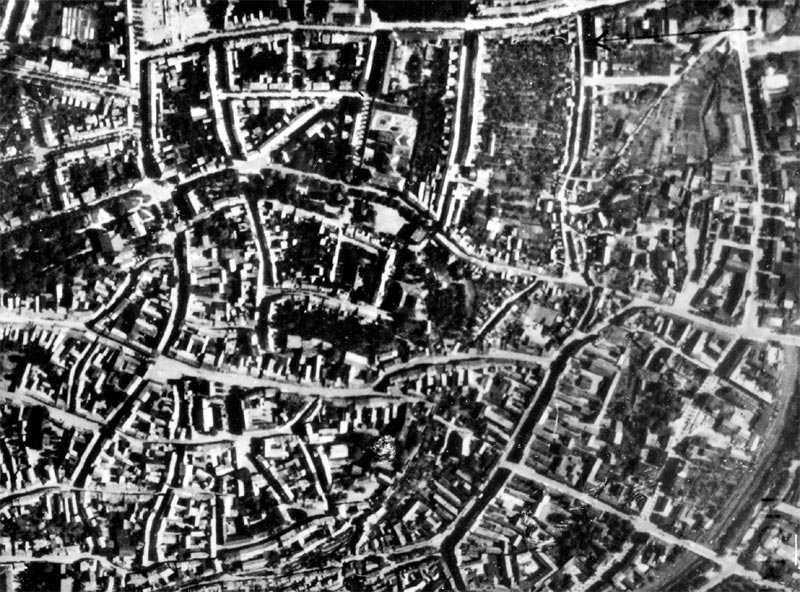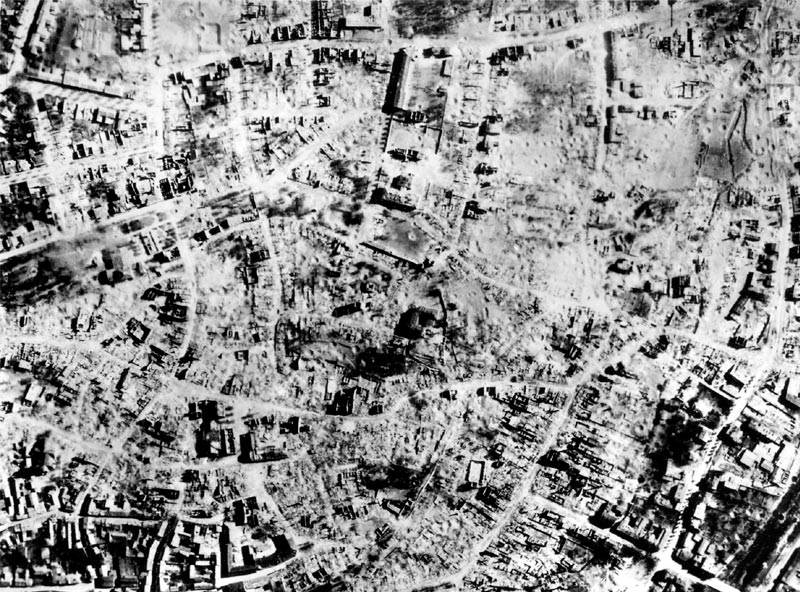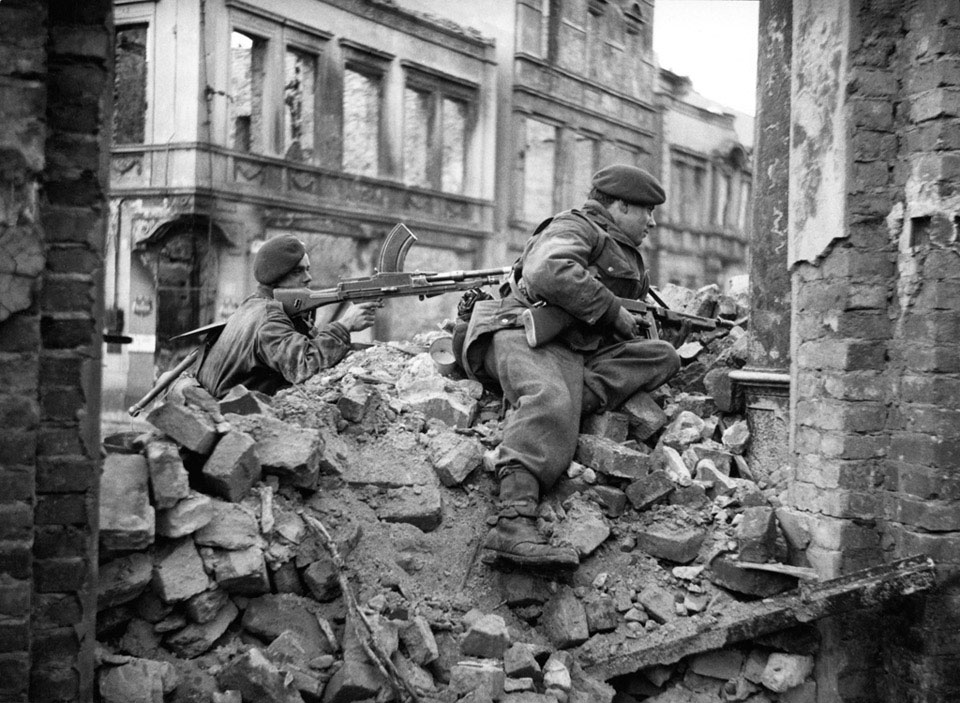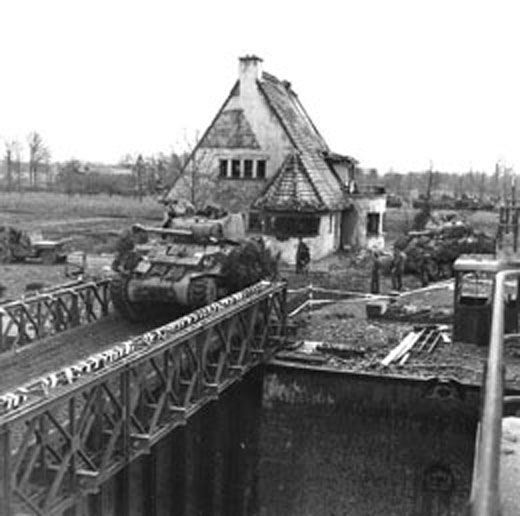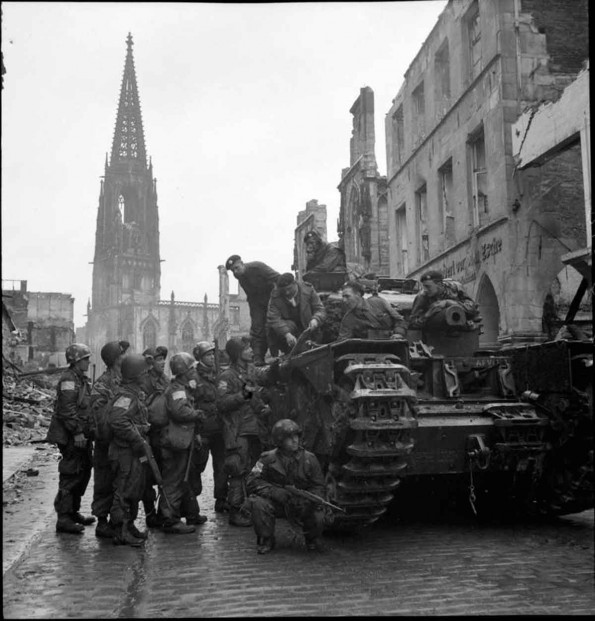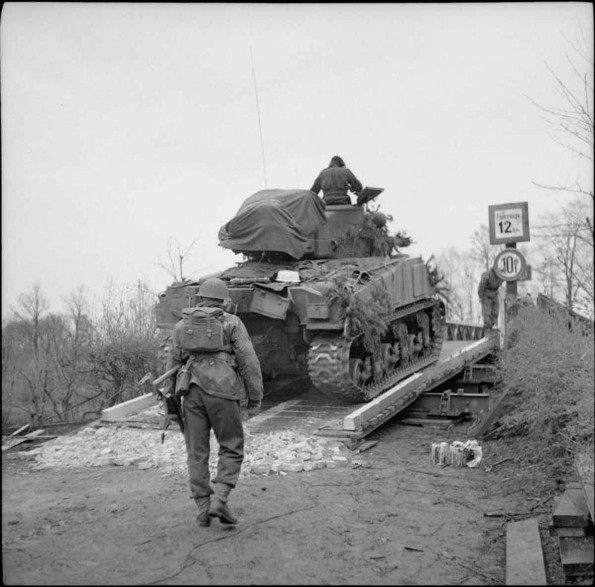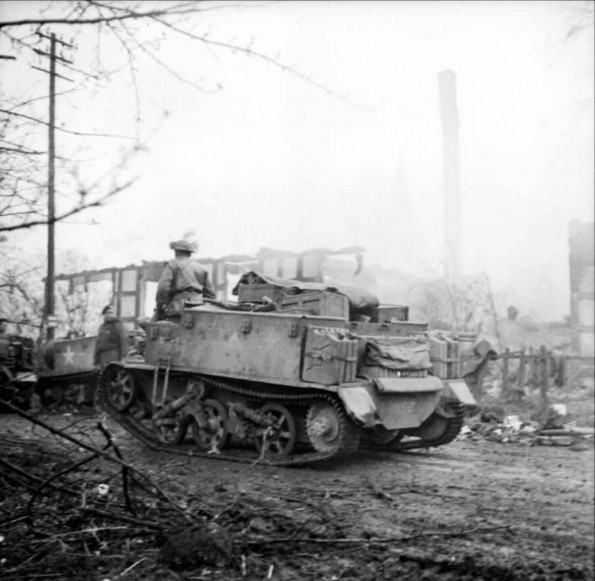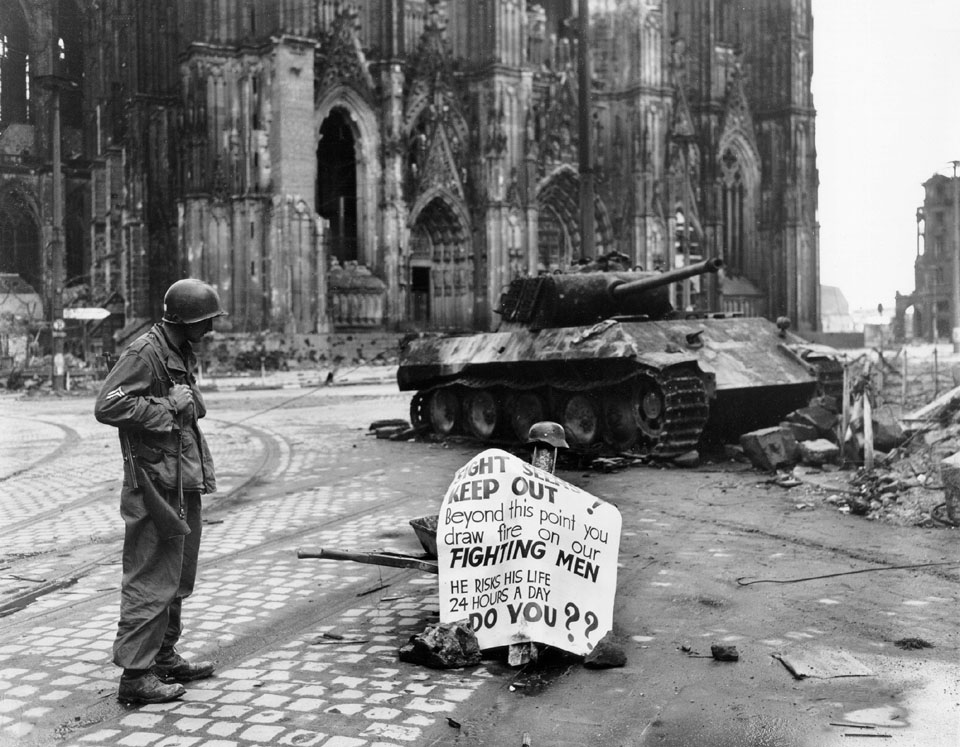Air Operations, CBI
BURMA- Despite bad weather, 10th Air Force fighter-bombers are able to mount light attacks against Japanese Army troops and supplies in central Burma.
- 41 22nd and 43rd Heavy Bomb group B-24s attack the port area and Royal Navy Yard at Hong Kong. 2 vessels are declared destroyed in a dry-dock area and bombs also hit a power plant and oil stores.
- 2341st Medium Bomb Group B-25s attack a junk in the Gulf of Tonkin.
- 6 P-38s strafe motor vehicles in the Dien Bien Phu area.
Air Operations, Europe
RAF BOMBER COMMANDDaylight Ops:
- 243 Lancasters and 1 Mosquito of No. 5 Group, with 8 Pathfinder Mosquitos, attack the barracks and the town of Nordhausen, which is severely damaged.
- 1 Lancaster is lost.
- 327 Lancasters and 14 Mosquitos of Nos. 3, 6 and 8 Groups attack the synthetic oil plant at Leuna. The target is cloud-covered and the bombing is scattered and only minor damage is caused.
- 2 Lancasters are lost.
- 327 aircraft including 277 Halifaxes, 36 Lancasters and 14 Mosquitos of Nos. 4, 6 and 8 Groups attack the Rhenania oil plant in Harburg. The target is easily identified and severe damage is caused to it.
- 2 Lancasters and 1 Halifax are lost.
- 258 Lancasters and 14 Mosquitos of Nos. 1 and 8 Groups attack the oil refinery at Lützkendorf. Bomber Command claims 'moderate damage'.
- 6 Lancasters are lost.
- 35 Mosquitos are sent to Berlin and 31 to Magdeburg, 30 Lancasters lay mines in the Oslo Fjord and the Kattegat and there are 66 Mosquito patrols and 70 RCM sorties.
- 5 aircraft are lost: 2 Mosquitos on the Magdeburg raid and 3 mine-laying Lancasters of No. 1 Group from the Kattegat operation. The 136 aircraft dispatched by No. 100 Group on this night are that group's largest effort of the war.
GERMANY:
- 199 1st Air Division B-17s attack three Luftwaffe airfields (two of which are secondaries).
- 22 1st Air Division B-17s attack a U-boat yard at Hamburg.
- 159 2nd Air Division B-24s of 438 dispatched attach three airfields (one of them a secondary).
- 505 3rd Air Division B-17s attack a shipyard at Kiel.
- 10 heavy bombers and 4 of 812 VIII Fighter Command escorts are lost.
- P-51 pilots of the VIII Fighter Command's 339th Fighter Group claim 105 Luftwaffe aircraft destroyed on the ground during strafing attacks.
GERMANY:
- More than 330 9th Air Division bombers attack an oil depot, a supply depot, a marshalling yard, a barracks, a defended town, and a road and rail junction.
- 8th and 9th Air Force fighter pilots down 34 Luftwaffe aircraft between 0800 and 1830 hours.
ITALY:
- 12th Air Force B-25s attack bridges on both sides of the Brenner Pass, and a methane plant at Merano.
- XXII TAC P-47s attack rail lines, fuel and ammo dumps, and German Army forces on the move in the Po River valley.
- During the night, XXII TAC A-20s and A-26s attack bridges at seven locations.
GERMANY:
- While escorting a 15th Air Force bomber mission against targets around Munich, 325th Fighter Group P-51 pilots down 5 FW-190s over southern Germany between 1545 and 1635 hours.
Air Operations, Formosa
- V Bomber Command B-24s attack the airfield at Toyohara and Tokochito Island.
- 12 V Bomber Command B-25s attack the Mako naval base in the Pescadore Islands, where they destroy 2 small tankers.
- V Bomber Command A-20s attack rail yards and factories at Shinchiku, and a factory at Suan Tau.
Air Operations, Philippines
- 24 494th Heavy Bomb Group B-24s attack Bunawan.
- XIII Bomber Command B-24s attack targets in central Mindanao.
- V Bomber Command A-20s attack targets on Luzon and northwestern Negros.
- V Fighter Command P-38s and P-51s attack targets on Luzon.
Air Operations, Ryukyus
- Despite bad weather, US Navy carrier aircraft support US 10th Army ground forces on Okinawa.
- A VF-84 F4U downs a G4M 'Betty' bomber northwest of Okinawa at 0215 hours.
- A VF-83 F6F downs a Ki-51 'Sonia' bomber over Okinawa at 0415 hours.
- VBF-6 F4Us down 2 A6M Zeros southwest of Okinawa at 0745 hours.
- A VF-6 F6F downs a utility airplane at sea at 0753 hours.
- A VF-29 F6F downs a B6N 'Jill' torpedo bomber at sea at 1815 hours.
Allied Planning
Gen Eisenhower order Gen Omar N. Bradley's 12th Army Group to attack from Kassel to Leipzig and establish a bridgehead over the Elbe River. Bradley will be the main effort in the final defeat of Germany. Field Marshal Bernard L. Montgomery's 21st Army Group is also to advance to the Elbe River and then north along the Baltic coast, but will primarily protect Bradley's left flank. Lt-Gen Jacob L. Devers's 6th Army Group is to protect Bradley's southern flank and advance to Bayreuth, then be prepared to advance to Nürnberg and Linz. The British Chiefs of Staff notify Eisenhower that his plan for the final offensive in Germany is indadequate. Having Montgomery's 21st Army Group advance to Bremen, then to the Elbe River, ignores Berlin as a critical objective that must be occupied before the Soviets get to the capital. Eisenhower believes Berlin is no longer a militar objective. The Soviet advance and heavy Allied bombing have rendered it useless as a military objective. Eisenhower believes that SHAEF's mission is to focus on German military forces and not on political issues.
[Baltic Sea
- U-237 is destroyed while under construction at Kiel in a raid by the US 8th Air Force. U-237 had been sunk once before at Kiel on May 14, 1943 and was refloated October 8, 1943.
- U-749 and U-3003 (under construction) are also destroyed in this same raid.
| Class | Type VIIC/41 |
| CO | Kapitänleutnant Karl Heinz Menard |
| Location | Baltic, Kiel |
| Cause | Air attack |
| Casualties | Unknown |
| Survivors | Unknown |
|
|
Battle of the Atlantic
US army aircraft sink more German submarines including U-237, U-749 and U-3003 at Kiel, Germany.
[Eastern Front
Advancing from positions southwest of Nowy Targ, in Poland, the 4th Ukraine Front, supported by Czechoslovak units, opens the offensive along the Polish-Czech frontier in the direction of Bohemia; the 2nd Front takes the important road and rail junction of Bratislava.
In Austria, advance guards of the 3rd Ukraine Front and Bulgarian troops are now only 2 miles from Vienna. The 2nd and 3rd Ukraine Fronts have together completely liberated Hungary and the 3rd Ukraine Front is advancing in Yugoslavia. The Germans admit the loss of Baden and announce that they are counterattacking in the are of Moravska-Ostrava and Nitra.
In East Prussia the Germans form the Silesia battle group at Swinemünde (Swinoujscie). Gen Gotthard Heinrici has taken over command of the Vistula Army Group.
EAST PRUSSIAThe final reduction of Königsberg begins as the Soviet 11th Guards, 39th, 48th and 50th Armies probe the perimeter defenses.
SLOVAKIAThe 7th Guards Army takes Bratislava.[MORE]
[Okinawa
The situation changes radically. All the American units find themselves facing extremely tenacious resistance carried out from well-sited and well-camouflaged positions both in the north and in the south along the Shuri Line. Hodge's troops are brought to a halt on a line just south of Kuba while Geiger's have reached the Ishikawa Isthmus.
Learing that the Japanese intend to launch a huge air attack against the invasion fleet, the Americans decide to attack Kyushu Island, where aircraft of various types have been assembled for the kamikaze assault. The US high-speed transport Dickerson (APD-21) is damaged by a suicide plane and later is sunk by US forces. Because of bad weather 11 US tank landing craft (LST-70, LST-166, LST-343, LST-399, LST-570, LST-624, LST-675, LST-689, LST-736, LST-756 and LST-781) run aground off Okinawa.
[Pacific
The Japanese escort vessel Mokuto is sunk by mine in Shimonoseki Strait along with the merchant cargo ship Hozan Maru (1175t).
[Philippines
On Luzon the US 158th Regimental Combat Group, landed on April 1 at Legaspi in the south of the island, advances slowly northward, doggedly opposed by the Japanese.
In the XIV Corps area, the 1st Cavalry Division and the 11th Airborne Division conduct a double envelopment, trapping about 1,600 Japanese troops at Tiaong.
[Western Front
In the British 2nd Army sector both the XXX and the XII Corps succeed in establishing bridgeheads over the Dortmund-Ems Canal, one near Lingen, the other near Rheine. Some units of the VIII Corps enter Osnabrück while others press on toward Minden on the Weser River.
The US 9th and 1st Armies continue to press from north and south against the Ruhr pocket, and at the same time to push east in the direction of the Weser River. Units of the 9th Army reach the Weser opposite Hameln.
The garrison at Kassel surrenders to the troops of the 80th Div, XX Corps, US 3rd Army. Other units of Patton's force are advancing near Erfurt after taking Gotha.
The US 4th Arm Div liberates the concentration camp outside Ohrdruf, the first of the infamous prisons reached by the Allies from the west. Gen Patton, who vomited on visiting the site, rounds up the townspeople to witness the horrors which had been perpetrated in their immediate area. Many victims are still lying where thay had been shot by the retreating Nazis. Ohrdruf's burgomaster and his wife are among those brought to the camp by Patton. When they returned home, they hanged themselves.
The French 1st Army takes Karlsruhe and then moves southwest toward Freiburg and southeast toward Tübingen.
[Images from April 4, 1945
|
|
|
|
|
|
|
|
|
|
